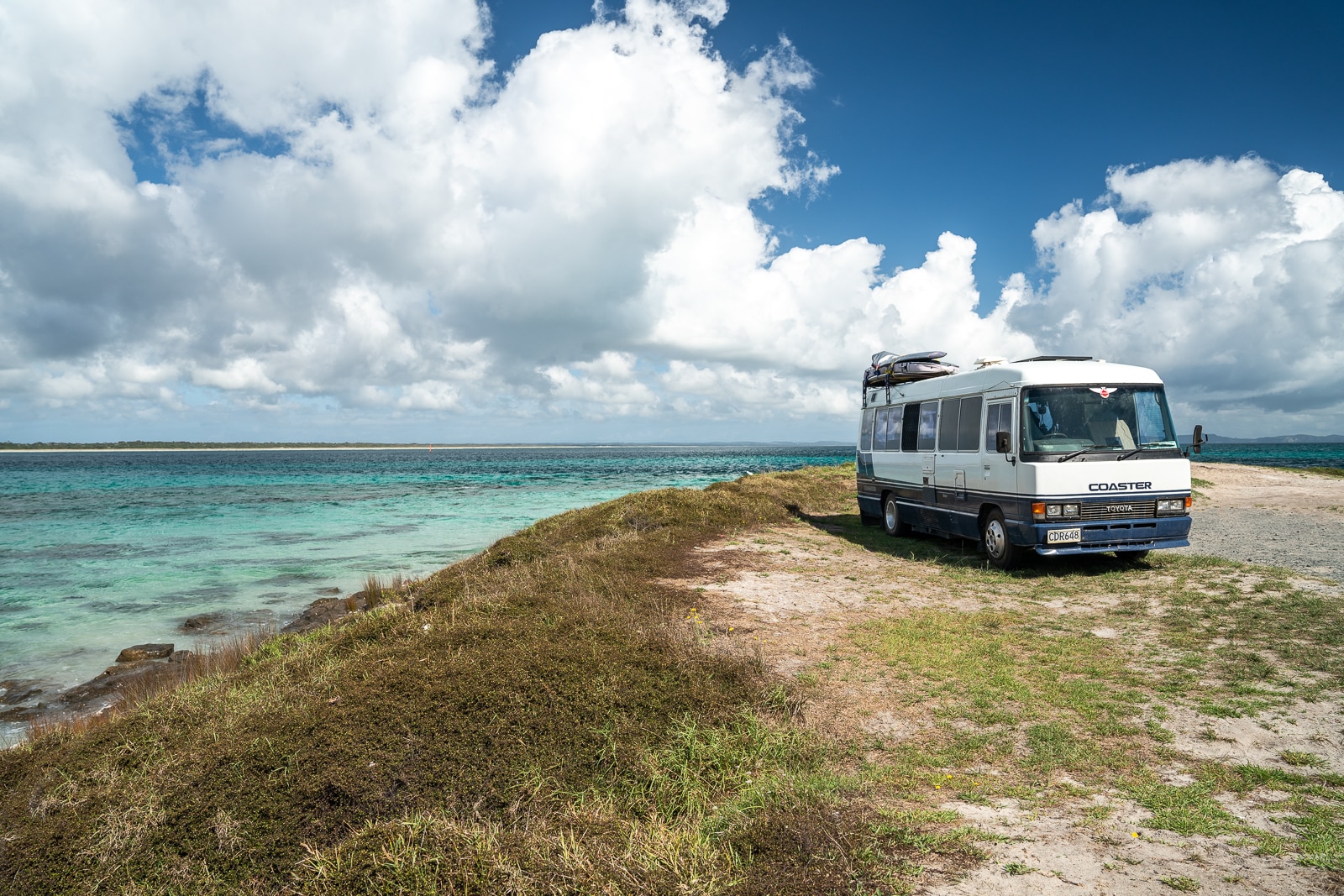
Endless Summer – Road-Tripping the Far North
By Kim Hobson
Dreaming of the Beach Life
I couldn’t recall the last time I’d been up to the far North, but quickly came to the realisation that it had been way too long.
We’d completed the South Island leg of our road trip, we’d spent Christmas in Auckland with family, we’d been sailing with a friend for a couple of weeks, and we’d spent some time in the Coromandel.
Summer was far from over though, and the Northland beach-gyspy life was calling to us.
Some minor bus issues had us slightly delayed and we were stuck in Auckland a bit longer than expected, but it was fun spending extra time with family and friends.
After picking up the freshly COF’d bus up from the COF provider we were finally on our way.
We’d initially planned to spend at least 4 weeks cruising the far North, but now only had a 3 and a half week window before we had to be back in Auckland for a festival.
A major aspect of life on the road is being flexible with time and adaptable when things don’t go to plan, which is not always an easy pill to swallow. But what can I say – first world problems right?
There are some valuable life lessons to be gained from these less-than-ideal situations, and we were gradually learning patience and surrender.
First Stop - Tutukaka
The rough plan for our first day driving North was basically just to see how far we could get. Most of the time, we just keep driving until we find a location that kind of just feels “right.”
So on we drove, past Whangarei, all the way to the Tutukaka Coast, which is an area we’d both been interested in checking out ever since sailing to the Poor Knights the month prior.
The Tutukaka Coast is a cluster of rocky shorelines, pretty inlets and sandy beaches, and is famously known as the gateway to the Poor Knights Islands Marine Reserve – New Zealand’s premium dive location.
Seriously, if you haven’t been snorkelling or diving at the Poor Knights yet, put that at the TOP of your list.
It’s an unreal experience and you’ll be blown away to see what a healthy marine ecosystem actually looks like! I only wish we’d had underwater housing for our camera so we could’ve captured the magic below.
Feeling satisfied with our recent Poor Knights experience, we were content just chilling at the beaches of Tutukaka, which has a couple of a beautiful freedom camping options.
Matapouri and Whale Bay
From Tutukaka we continued to Matapouri Beach, a quaint coastal holiday town with original kiwi baches lining a crescent shaped bay.
There’s a freedom camping spot right on the beach, with only a small number of overnight parking spots.
Northland Regional Council only allows a 1 night stay at its freedom camping locations, but it seemed the rules were a bit more relaxed with the summer holiday rush being long over, so we took a little liberty and stayed an extra night.
Within hours of arriving, our vanlife neighbour’s adorable dog befriended us, and we dog-sat for her while she went for a run.
That’s one of my favourite things about life on the road – it’s like one big travelling community. Everyone is really friendly and supportive, and you meet an eclectic bunuch of like-minded individuals with some outstanding life stories.
Naturally we spent most of our time in the water, escaping the blistering heat. Some of the best swims we had all summer were at Matapouri Bay, its crystal clear waters cool and inviting in that baking Northland sun.
At one end of the beach is the access point to Whale Bay walkway, a 40 min (one way) cliff-top walk to an idyllic pohutukawa-lined cove, looking like a scene straight out of a postcard.
We walked the track more than once, enjoying the views along the way with the reward of a refreshing swim in Whale Bay’s tropical waters at the end.
Maitai Bay & Waikato Bay - Kari Kari Peninsula
Next on the travel itinerary was Kari Kari Peninsula, a part of the country neither of us had ever been before.
Kari Kari Peninsula is a remote slice of paradise just past Doubtless Bay, known for its secluded white sandy beaches.
We spent about a week at the Maitai Bay DoC Campsite, overlooking the popular Maitai Bay. Sunrise beach yoga, countless swims, and the regenerative energy of the sea – the stuff summer dreams are made of.
There was even a resident pig that would routinely visit the campsite from a neighbouring farm. He was a rather friendly, rotund little dude, and could sometimes be found frolicking in the shallows.
Just around the corner from Maitai Bay is Waikato Bay. Our favourite swim-spot was at the far end of Waikato Bay, where a cluster of boulders form a natural pool bordered by a huge pohutukawa tree.
After a day or two of heavy on-shore wind, we walked along Maitai Bay picking up bits of plastic that had been washed ashore by the currents, noticing a disturbing number of dead Little Blue Penguins.
Our seabirds face serious threats from plastic pollution and overfishing, and we were happy to see the local Iwi had placed a Rahui on fishing and seafood-collecting in the area. These fragile ecosystems need time to replenish themselves.
Rangiputa - Kari Kari Peninsula
From Maitai Bay we moved on to Rangiputa, another small holiday town that resembles some kind of tropical exotic paradise.
There’s a small peninsula on a rocky point where you can freedom camp, tucked away from the main beach and all the baches.
It’s a popular spot for those in the know, but there was plenty of space, and we easily found ourselves a park overlooking the water.
The views were stunning, with glowing sunsets across the bay each night. Once again we met plenty of friendly travellers, and the locals were very welcoming too.
At the main beach, there’s a walkway along the waterfront, which has been lovingly landscaped by a local gardener.
We wandered along this artful garden trail, finding our own private swim-spots in Rangiputa’s refreshing turquoise waters along the way.
With its white sandy beaches lined with tropical plants, Rangiputa really did feel like a lush slice of paradise right here in New Zealand, and we never even knew it existed!
Tsunami Scare at Houhora Heads
Soon enough we were on the road again, ending up at a quaint little seaside campsite at Houhora Heads.
We made the most of some decent showers and the opportunity to do some washing.
The next day we were bombarded with a tsunami alert, and everyone had to evacuate the campsite and head for higher ground.
The campsite staff advised us to head inland at Pukenui, where we ended up spending half a day parked up with a bunch of other travellers and locals.
Everyone was a bit nervous at first, tuning in anxiously for regular updates on the radio. We soon eased into it though, and everyone gathered around to share a couple of massive watermelons that a local farmer had kindly dropped off.
One campervan traveller even provided some live banjo-music! Feeling like a little gyspy gathering in the middle of nowhere, it actually ended up being a somewhat festive day.
Finally the government gave the all-clear on the tsunami warning, and we decided there was nothing else for it but to head all the way to the very top of the Island.
The roads were eerily quiet as we travelled North. I guess people must have been keeping a low profile after the tsunami scare. Not us!
We trundled along in our bus as if nothing out of the ordinary had occurred, finally reaching the car park at Cape Reinga to find two other campervans leaving, and only one other car parked up.
Cape Reinga
It was a bright, sunny afternoon as we set out on the Cape Reinga track. We only encountered two other people along the way.
At least we weren’t the only mad dogs out and about after a tsunami warning!
We kind of figured the best place in Northland to be during a tsunami would likely be at the very top of the island, where it’s elevated enough to be safe but you can still view the sea.
Well, we didn’t see any sign of a tsunami that day, but the swell was definitely working, sending in set after set of rolling blue waves which crashed dramatically against the rocks.
Cape Reinga is known as the meeting place of the Tasman and Pacific Oceans, their waters colliding in a turbulent swirl of currents.
For Maori, Cape Reinga, or Te Rerenga Wairua, is the most spiritually significant location in the country.
After death, all Maori spirits travel up the coast, past the sacred pohutukawa tree at the headland and out to sea.
Without all the usual crowds, we felt we were really able to feel the true essence and powerful energy of this sacred place.
Sheer cliffs plunge down into the surging ocean below the track, while waves pummel the sandy shores of remote, windswept beaches.
The Te Paki Coastal Track cuts through coastal shrubbery along undulating cliffs, leading off into the wild landscape beyond.
The Te Paki Coastal Track is a multi-day tramp following the rugged coastline, with no huts and only camping available.
It’s definitely on our bucket list for another time, but our final destination for the day was a place I’d been dreaming about ever since I first visited as a kid – Tapotupotu Bay.
Tapotupotu Bay
Tapotupotu Bay is a remote bay nestled between bush-clad hills and tall cliffs, and here you’ll find New Zealand’s northenmost campsite.
Judging by how subdued Cape Reinga had been, we were expecting the DoC campsite to be pretty empty, but as we came over the hill we found to our surprise that it was almost full!
Luckily there were a few sites left, and we grabbed one of the last ones overlooking the beach. Here, we spent a relaxed few days exploring and getting some sun-and-sea therapy. Jeremy tried to get out for a surf but the waves were pretty wild, so he didn’t last long!
There’s a crystal clear inlet where you can swim and paddle-board at Tapotupotu Bay, and we went for nightly strolls along the beach as the last light of day set misty sea spray aglow in rusty-gold tones.
You can even hike all the way from Tapotupotu Bay to Cape Reinga, forming part of the Te Paki coastal track – it’s about 3 hours one way.
We noticed a few people from the campsite setting off with trekking poles and tramping boots, but we only walked about a quarter of the track, happy to leave the entire tramp for another time.
Te Paki Giant Sand Dunes
We weren’t entirely sure where we wanted to go next, but Jeremy was itching for a surf. Our first idea was to explore the Te Paki Giant Sand Dunes, another place neither of us had ever been before.
Te Paki is a narrow coastal strip of 150m high ever-shifting and evolving sand dunes, and is popular for sand-boarding.
Arriving at the carpark early in the morning, we set off up the steep, sandy dunes bare footed, feeling lucky to have this incredible natural attraction all to ourselves.
We were mesmerised by this surreal landscape as we climbed windswept ridge-lines, feeling like lonely desert wanderers crossing the Sahara.
Spirits Bay Through to Rarawa Beach
Our next stop was Spirits Bay, about 30 minutes from Te Paki Sand Dunes.
Situated at the end of a remote gravel road, this isolated bay is also considered to be a sacred location in Maori culture, where the spirits of the dead gather to depart this world to journey towards their ancestral home/afterlife.
We wandered along the vast beach as powerful waves pounded the shore, dragging themselves back to form rippling walls of frothy water, crashing and crumbling in a deafening roar to repeat the process again.
Like Cape Reinga, Spirit’s Bay has an atmosphere of omnipotence – an almost otherworldly essence that seems to permeate from that infinite open ocean.
About an hour South of Spirits Bay lies another piece of Northland paradise – Rarawa Beach, a long stretch of silky white sand with a crystalline tidal lagoon at one end.
It was sweltering hot so we dove into the lagoon’s pristine waters for a swim. The branches of lush pohutukawa trees brushed the surface of the aquamarine pool while the sun beat down from above.
Taupo Bay Through to Keri Keri
A small campsite at the picturesque Taupo Bay was our next home for the following couple of nights, where once again we made the most of washing machines and hot showers.
Taupo Bay is a legendary surf beach, boasting clean waves that seem to peel off perfectly every time.
Jeremy finally got the Northland surf session he’d been hoping for, while I relaxed on the beach practising my surf photography.
The weather was set to pack in a bit, and the NZMCA in Keri Keri was the perfect place to hunker down for a couple days of intermittent rain.
Keri Keri NZMCA is a cute campsite right next to a bush walk leading down to Rainbow Falls, which can be seen from a number of different viewing platforms.
We were keen for a swim in the swimming hole below the falls, but there was a sign warning that the water was unsuitable for swimming due to a high E-coli count – testament to the sad state of many of New Zealand’s rivers these days.
Campers at the NZMCA had told us that some people were still swimming at the falls, but we decided to play it safe.
Instead we opted for a little mission around the rocks which brought us to a cave behind the waterfall, alive with lush green mosses and ferns.
It was like we’d discovered a hidden fairy city behind a curtain of tumbling water – magical!
The Bay of Islands - Urupukapuka Island
The Bay of Islands was to be our next destination, and here we parked up at the Top Ten Holiday Park in the charming town of Russell to do a bit of exploring.
Friends of ours had recommended Urupukapuka Island to us, and after researching it online we decided we had to spend a night camping on the Bay of Islands’ largest island.
Urupukapuka Island is a short ferry ride from Russell or Paihia, with three DoC campsites located at various beaches.
We chose to camp at Sunset Bay, a tiny tree-fringed cove with only two tent sites.
After disembarking the Ferry at the main beach, we came across a large cafe on a grassy lawn overlooking the water.
The America’s Cup sailing regatta was on at the time, so we stopped in to indulge in an obligatory a beer to watch the race.
After the race, we hitched our packs onto our backs and took a slow, ale-induced trudge to our campsite for the night.
There was another couple already at the campsite, and we chatted to them as we set up our tent before enjoying a cruisy evening of swimming and sunset-gazing.
The stars were out in force later that night too, the milky way glowing radiantly above the calm sea.
In the morning we packed our bags and dumped them under a bush so that we could enjoy a day of pack-free exploring.
The walking track leads across some farmland into the bush, where we spotted an abundant amount of saddleback/tieke – a rare species of wattlebird endemic to New Zealand.
We hadn’t seen any tieke since we’d been to Tiri Tiri Matangi Island years ago, so we were thrilled to see these beautiful birds thriving on their little piece of island paradise.
The trail then winds around the island, past idyllic beaches and over rocky cliffs, with views of island-studded bays in every direction.
We were all the way on the far side of the Island as the weather began to back in, so we donned our wet weather gear and embraced a rainy trek back to the ferry.
From Russell back to Auckland via Elliot Bay
It had been a great couple of days, and back in Russell we were freshly showered and ready for a couple of beers on the “town”.
We watched the final of the America’s Cup at the classic Duke of Marlborough Hotel, enjoying a colourful sunset from the verandah of the Hotel restaurant.
Hunger soon took hold so we headed around the corner to Hone’s Garden for some pizza – I highly recommend Hone’s! Amazing pizza and a great vibe!
The place is obviously popular because it was packed, and there was even a rowdy group of ladies on a hens’ do to provide some characteristically lewd entertainment.
The next day we took off again, savouring a scenic drive past Oakura and Helena Bay, stopping off to explore Elliot Bay before continuing on past Whangarei to visit some friends just outside of Wellsord.
And thus ended our Northland adventure – we’d had a solid dose of the nomadic beach life, we were feeling rested and ready to hit Splore festival, and we were already scheming to come back to do a few hikes as well as explore Northland’s West Coast another time.
Road Trip Itinerary:
- Tutukaka Coast – freedom camping (must be certified self contained)
- Matapouri Bay – freedom camping (must be certified self contained)
- Whale Bay walkway – 40 min one way
- Kari Kari Peninsula – Maitai Bay Conservation Campsite ($15 per night – adult, bookings not required)
- Rangiputa – freedom camping (must be certified self contained)
- Hohoura Heads (Wagener) Holiday Park – https://www.wagenerholidaypark.co.nz/ – $17 – $20 per night (adult)
- Cape Reinga/Te Rerenga Wairua Lighthouse Walk – 300m, 10 mins (easy)
- Tapotupotu Conservation Campsite – $15 per night (adult), bookings not required
- Tapotupotu Bay to Cape Reinga walk – 5km/3 hr one way (easy)
- Te Paki Giant Sand Dunes – 47 Te Paki Stream Road, Cape Reinga (free)
- Kapowairua (Spirits Bay) Conservation Campsite – $15 per night (adult), bookings not required
- Rarawa Beach Conservation Campsite – $15 per night (adult), bookings not required
- Rarawa Beach Walk – 500m/20 min (begins from either day visitor parking or campsite)
- Taupo Bay Holiday Park – https://www.taupobayholidaypark.co.nz/ – sites from $36 to $65
- NZMCA Keri Keri – $3 per night per person for NZMCA members – for more info see https://www.nzmca.org.nz/
- Rainbow Falls Walk, Keri Keri – 400m/10 min one way (easy)
- Russell Top Ten Holiday Park – https://www.russelltop10.co.nz/ – sites from $41 per night
- Urupukapuka Island – ferry from Russell to Oteihei Bay – https://www.exploregroup.co.nz/otehei-bay/otehei-bay-ferry/ – $50 per adult (duration 40 min one way), Sunset Bay Conservation Campsite – $15 per night (adult), bookings required
- Urupukapuka Island Walk – 7.3km/5 hr (easy)
- Elliot Bay – Rawhiti Road (between Russell & Oakura)
Share:
Related Posts
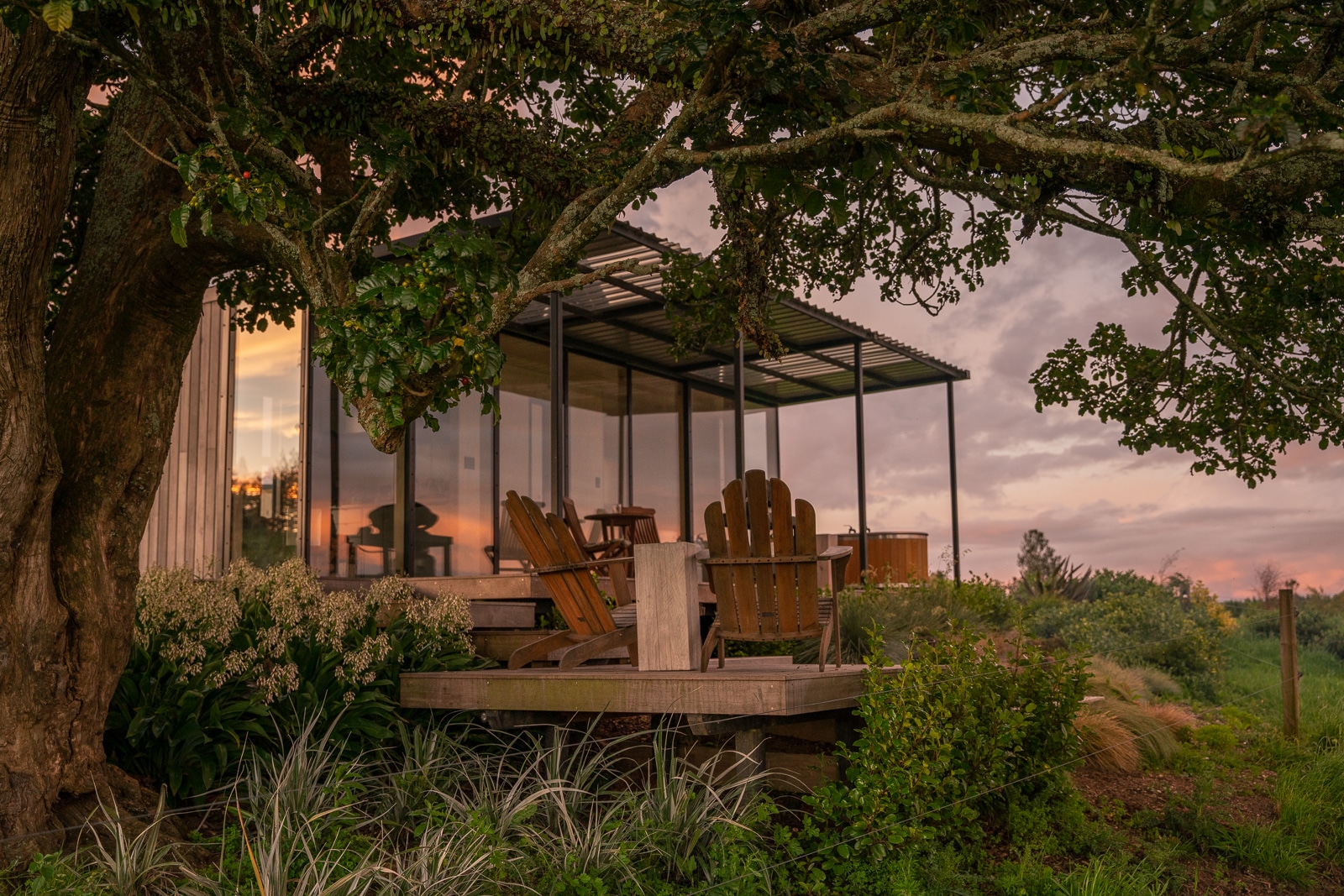
An Exciting Surprise! Redwood Farm Glamping – Canopy Camping Escapes
Redwood Farm Tiny House sits on a ridge overlooking rolling pastoral hills. A sunny spot fully equipped with everything you need – it’s the perfect couples’ getaway for those after a touch of romance.
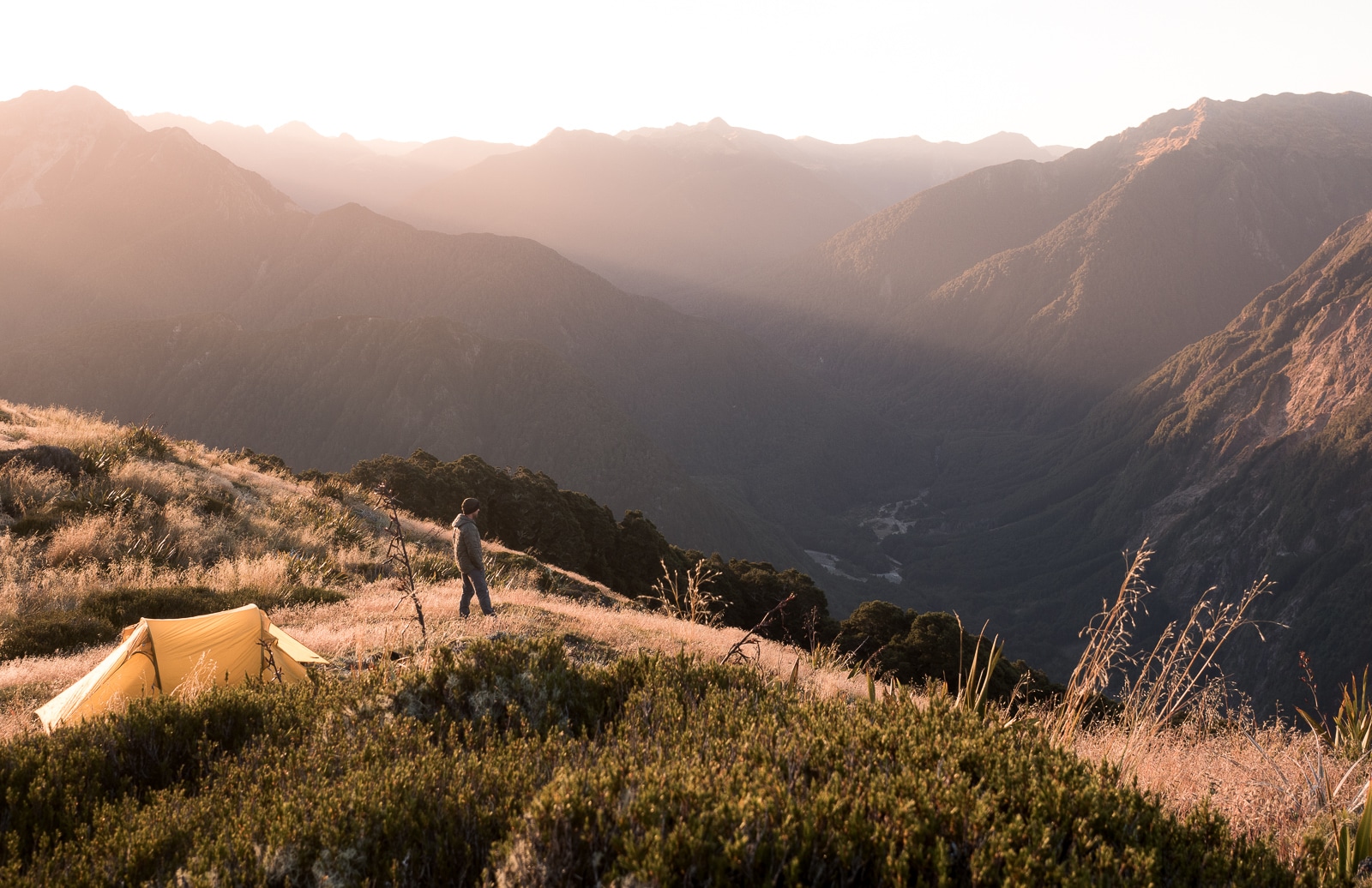
Seeking the Sublime – Wild Camping off the Beaten Path of the Wangapeka Track
Somewhere off the beaten path of the Wangapeka Track, lies the most sublime wild camping setting deep in the heart of the Kahurangi National Park. We endured the blistering heat of a summer heatwave in Nelson to seek solitude and wonder in the mountains
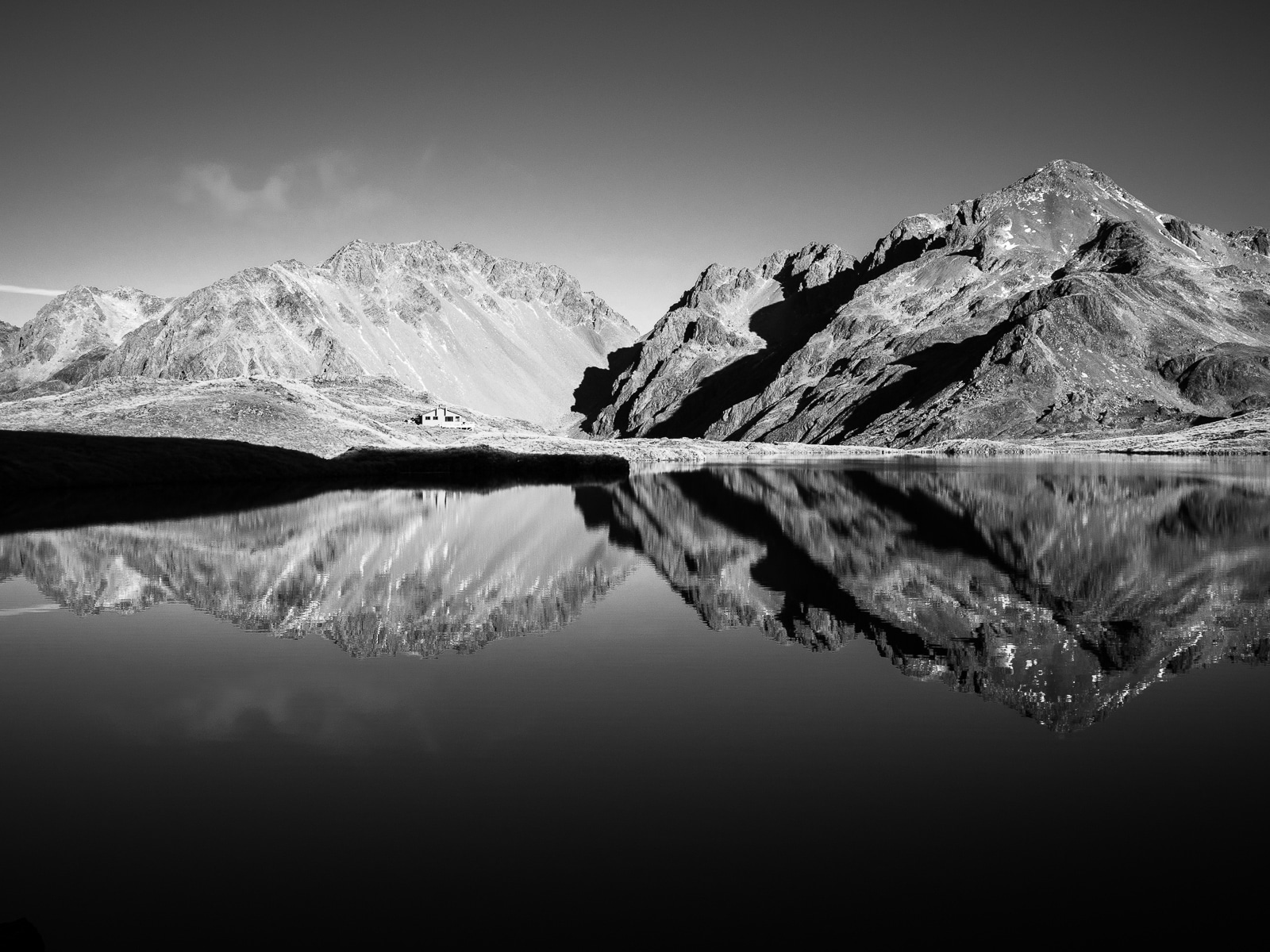
8 Key Elements for Powerful Black and White Photography
Black and white photography is a timeless, classic style that can convey emotion powerfully. We share some of the key features we’ve learnt to help create compelling black and white images.
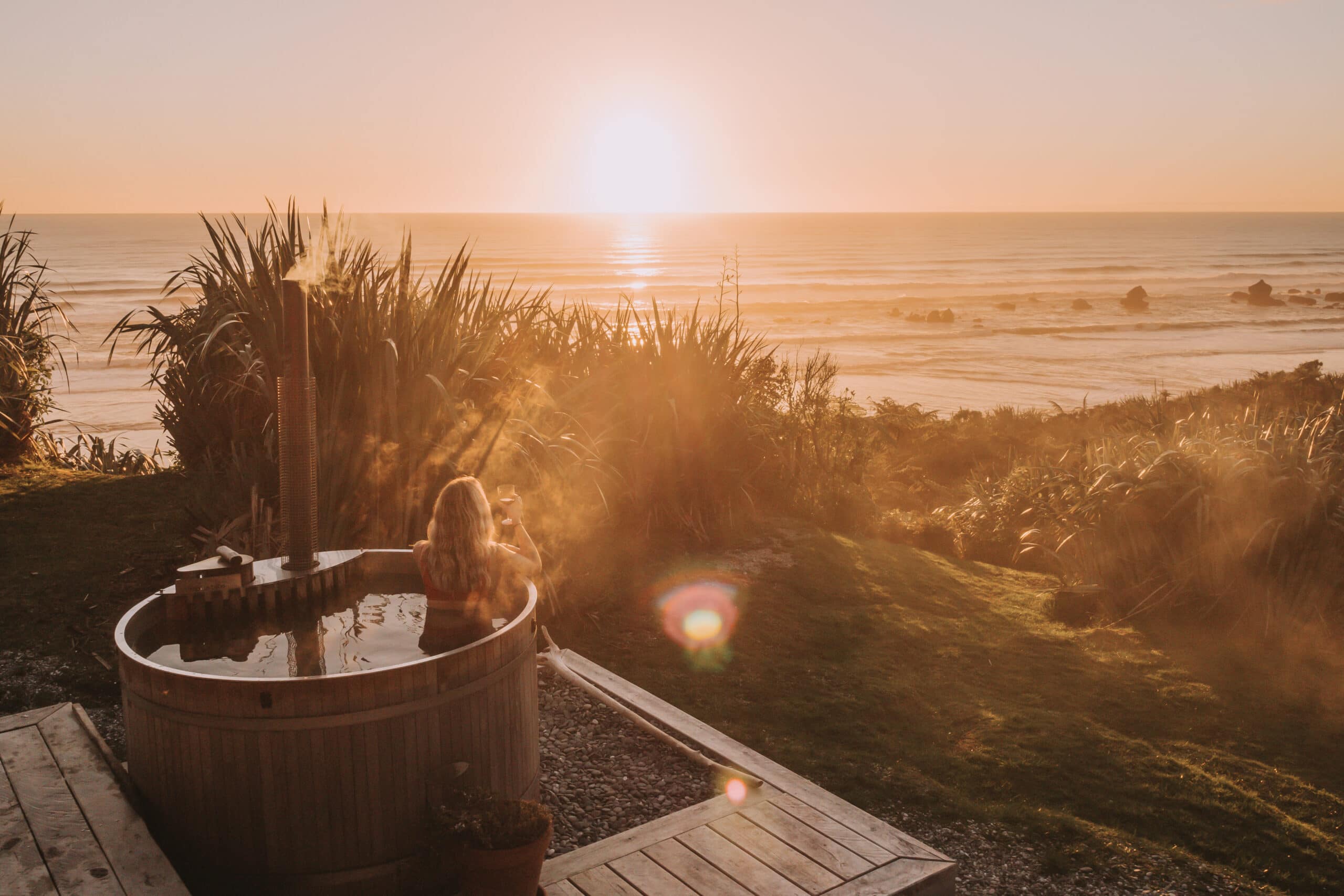
A West Coast Getaway – Glamping at Woodpecker Hut
It’s never a bad time to indulge in a bit of glamping, and Woodpecker Hut on the South Island’s West Coast is a feast for all the senses. We ditched the rat race for a weekend of solitude and rest in one of the country’s most scenic locations.
